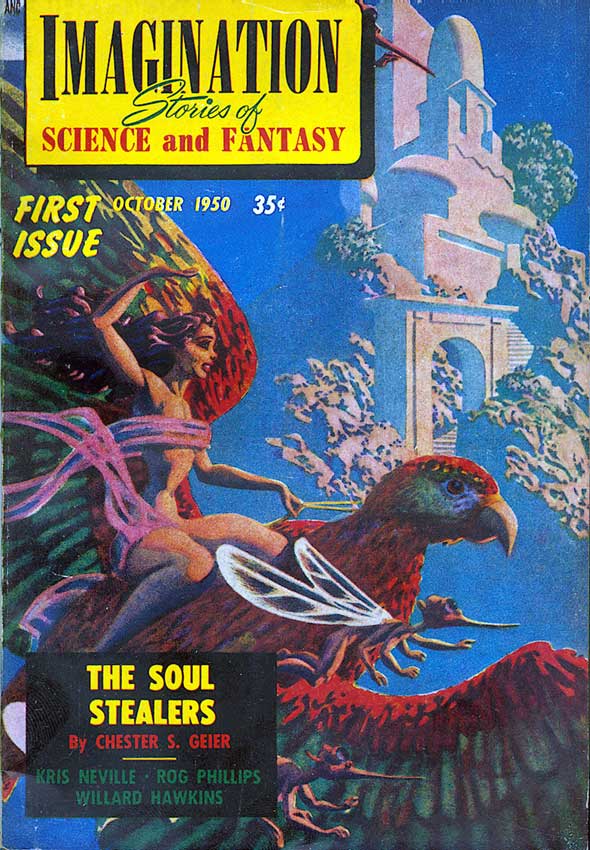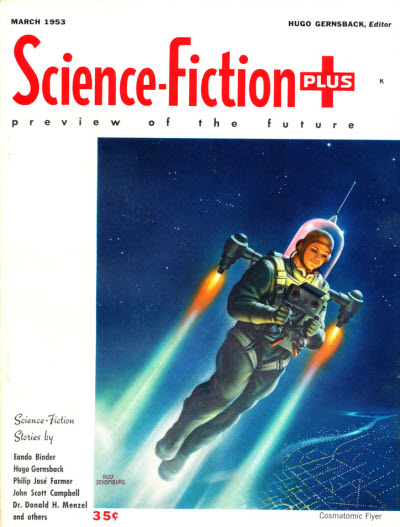|
Witches Three
''Witches Three'' is an anthology of three original fantasy stories, edited by the uncredited Fletcher Pratt and published in hardcover by Twayne in 1952. No further editions of the anthology were issued, but each of the stories was later republished. ''Witches Three'' was the second and last in the publisher's "Twayne Triplets," a series of science fiction and fantasy anthologies of which each was to be written by a trio of writers on a common theme. The theme for ''Witches Three'' is witches and witchcraft. Contents *"Introduction" by John Ciardi. the opening piece discusses "the symbolism of witches, in these stories and in folklore generally."Davenport, Basil. "Out of This World," in ''The New York Times'', Dec. 14, 1952, p. BR16. *''Conjure Wife'', by Fritz Leiber *"There Shall Be No Darkness", by James Blish *'' The Blue Star'', by Fletcher Pratt Reception Basil Davenport, reviewing the anthology in ''The New York Times'', called the book "an unusually generous omnibus, ... [...More Info...] [...Related Items...] OR: [Wikipedia] [Google] [Baidu] |
WikiProject Novels
A WikiProject, or Wikiproject, is a Wikimedia movement affinity group for contributors with shared goals. WikiProjects are prevalent within the largest wiki, Wikipedia, and exist to varying degrees within sister projects such as Wiktionary, Wikiquote, Wikidata, and Wikisource. They also exist in different languages, and translation of articles is a form of their collaboration. During the COVID-19 pandemic, CBS News noted the role of Wikipedia's WikiProject Medicine in maintaining the accuracy of articles related to the disease. Another WikiProject that has drawn attention is WikiProject Women Scientists, which was profiled by '' Smithsonian'' for its efforts to improve coverage of women scientists which the profile noted had "helped increase the number of female scientists on Wikipedia from around 1,600 to over 5,000". On Wikipedia Some Wikipedia WikiProjects are substantial enough to engage in cooperative activities with outside organizations relevant to the field at issue. For e ... [...More Info...] [...Related Items...] OR: [Wikipedia] [Google] [Baidu] |
The New York Times
''The New York Times'' (''the Times'', ''NYT'', or the Gray Lady) is a daily newspaper based in New York City with a worldwide readership reported in 2020 to comprise a declining 840,000 paid print subscribers, and a growing 6 million paid digital subscribers. It also is a producer of popular podcasts such as '' The Daily''. Founded in 1851 by Henry Jarvis Raymond and George Jones, it was initially published by Raymond, Jones & Company. The ''Times'' has won 132 Pulitzer Prizes, the most of any newspaper, and has long been regarded as a national " newspaper of record". For print it is ranked 18th in the world by circulation and 3rd in the U.S. The paper is owned by the New York Times Company, which is publicly traded. It has been governed by the Sulzberger family since 1896, through a dual-class share structure after its shares became publicly traded. A. G. Sulzberger, the paper's publisher and the company's chairman, is the fifth generation of the family to head the pa ... [...More Info...] [...Related Items...] OR: [Wikipedia] [Google] [Baidu] |
Imagination (magazine)
''Imagination'' was an American fantasy and science fiction magazine first published in October 1950 by Raymond Palmer's Clark Publishing Company. The magazine was sold almost immediately to Greenleaf Publishing Company, owned by William Hamling, who published and edited it from the third issue, February 1951, for the rest of the magazine's life. Hamling launched a sister magazine, ''Imaginative Tales'', in 1954; both ceased publication at the end of 1958 in the aftermath of major changes in US magazine distribution due to the liquidation of American News Company. The magazine was more successful than most of the numerous science fiction titles launched in the late 1940s and early 1950s, lasting a total of 63 issues. Despite this success, the magazine had a reputation for low-quality space opera and adventure fiction, and modern literary historians refer to it in dismissive terms. Hamling consciously adopted an editorial policy oriented toward entertainment, asserting in an ea ... [...More Info...] [...Related Items...] OR: [Wikipedia] [Google] [Baidu] |
Mark Reinsberg
Mark may refer to: Currency * Bosnia and Herzegovina convertible mark, the currency of Bosnia and Herzegovina * East German mark, the currency of the German Democratic Republic * Estonian mark, the currency of Estonia between 1918 and 1927 * Finnish markka ( sv, finsk mark, links=no), the currency of Finland from 1860 until 28 February 2002 * Mark (currency), a currency or unit of account in many nations * Polish mark ( pl, marka polska, links=no), the currency of the Kingdom of Poland and of the Republic of Poland between 1917 and 1924 German * Deutsche Mark, the official currency of West Germany from 1948 until 1990 and later the unified Germany from 1990 until 2002 * German gold mark, the currency used in the German Empire from 1873 to 1914 * German Papiermark, the German currency from 4 August 1914 * German rentenmark, a currency issued on 15 November 1923 to stop the hyperinflation of 1922 and 1923 in Weimar Germany * Lodz Ghetto mark, a special currency for Lodz Ghetto. * ... [...More Info...] [...Related Items...] OR: [Wikipedia] [Google] [Baidu] |
Science Fiction Adventures (1952 Magazine)
Between 1952 and 1954, John Raymond published four digest-size science fiction and fantasy magazines. Raymond was an American publisher of men's magazines who knew little about science fiction, but the field's rapid growth and a distributor's recommendation prompted him to pursue the genre. Raymond consulted and then hired Lester del Rey to edit the first magazine, ''Space Science Fiction'', which appeared in May 1952. Following a second distributor's suggestion that year, Raymond launched ''Science Fiction Adventures'', which del Rey again edited, but under an alias. In 1953, Raymond gave del Rey two more magazines to edit: ''Rocket Stories'', which targeted a younger audience, and ''Fantasy Magazine'', which published fantasy rather than science fiction. All four magazines were profitable, but Raymond did not reinvest the profits in improving the magazines and was late in paying contributors. Del Rey persuaded Raymond to invest some of the profits back into the magaz ... [...More Info...] [...Related Items...] OR: [Wikipedia] [Google] [Baidu] |
Damon Knight
Damon Francis Knight (September 19, 1922 – April 15, 2002) was an American science fiction author, editor, and critic. He is the author of "To Serve Man", a 1950 short story adapted for ''The Twilight Zone''.Stanyard, ''Dimensions Behind the Twilight Zone'', p. 51. He was married to fellow writer Kate Wilhelm. Biography Knight was born in Baker City, Oregon in 1922, and grew up in Hood River, Oregon. He entered science-fiction fandom at the age of eleven and published two issues of a fanzine titled ''Snide''. Knight's first professional sale was a cartoon drawing to a science-fiction magazine, ''Amazing Stories''.Knight, "Knight Piece," Brian W. Aldiss & Harry Harrison, ''Hell's Cartographers'', Orbit Books, 1976, p. 105. His first story, "The Itching Hour", appeared in the Summer 1940 number of ''Futuria Fantasia'', edited and published by Ray Bradbury. "Resilience" followed in the February 1941 number of ''Stirring Science Stories'', edited by Donald A. Wollh ... [...More Info...] [...Related Items...] OR: [Wikipedia] [Google] [Baidu] |
Science-Fiction Plus
''Science-Fiction Plus'' was an American science fiction magazine published by Hugo Gernsback for seven issues in 1953. In 1926, Gernsback had launched ''Amazing Stories,'' the first science fiction magazine, but he had not been involved in the genre since 1936, when he sold ''Wonder Stories''. ''Science-Fiction Plus'' was initially in slick format, meaning that it was large-size and printed on glossy paper. Gernsback had always believed in the educational power of science fiction, and he continued to advocate his views in the new magazine's editorials. The managing editor, Sam Moskowitz, had been a reader of the early pulp magazines, and published many writers who had been popular before World War II, such as Raymond Z. Gallun, Eando Binder, and Harry Bates. Combined with Gernsback's earnest editorials, the use of these early writers gave the magazine an anachronistic feel. Sales were initially good, but soon fell. For the last two issues Gernsback switched the magazin ... [...More Info...] [...Related Items...] OR: [Wikipedia] [Google] [Baidu] |
Sam Moskowitz
Sam Moskowitz (June 30, 1920 – April 15, 1997) was an American writer, critic, and historian of science fiction. Biography As a child, Moskowitz greatly enjoyed reading science fiction pulp magazines. As a teenager, he organized a branch of the Science Fiction League. While still in his teens, Moskowitz became chairman of the first World Science Fiction Convention held in New York City in 1939. He barred several members of the rival Futurians club from the convention because they threatened to disrupt it. This event is referred to by historians of fandom as the "Great Exclusion Act". In the mid-1940s, Moskovitz founded the Eastern Science Fiction Association (ESFA), a science-fiction fandom organization based in Newark, New Jersey which held conventions. By the early 1950s, he began working professionally in the science fiction field. He edited ''Science-Fiction Plus'', a short-lived genre magazine owned by Hugo Gernsback, in 1953. He compiled about two dozen anthologies, ... [...More Info...] [...Related Items...] OR: [Wikipedia] [Google] [Baidu] |
Galaxy Science Fiction
''Galaxy Science Fiction'' was an American digest-size science fiction magazine, published in Boston from 1950 to 1980. It was founded by a French-Italian company, World Editions, which was looking to break into the American market. World Editions hired as editor H. L. Gold, who rapidly made ''Galaxy'' the leading science fiction magazine of its time, focusing on stories about social issues rather than technology. Gold published many notable stories during his tenure, including Ray Bradbury's "The Fireman", later expanded as ''Fahrenheit 451''; Robert A. Heinlein's ''The Puppet Masters''; and Alfred Bester's ''The Demolished Man''. In 1952, the magazine was acquired by Robert Guinn, its printer. By the late 1950s, Frederik Pohl was helping Gold with most aspects of the magazine's production. When Gold's health worsened, Pohl took over as editor, starting officially at the end of 1961, though he had been doing the majority of the production work for some time. Under Pohl ''Gala ... [...More Info...] [...Related Items...] OR: [Wikipedia] [Google] [Baidu] |
Groff Conklin
Edward Groff Conklin (September 6, 1904 – July 19, 1968) was an American science fiction anthologist. He edited 40 anthologies of science fiction, one of mystery stories (co-edited with physician Noah Fabricant), wrote books on home improvement and was a freelance writer on scientific subjects as well as a published poet. From 1950 to 1955, he was the book critic for ''Galaxy Science Fiction''. Born in Glen Ridge, New Jersey, Conklin was educated at Dartmouth College and Harvard University, and graduated from Columbia University in 1927. He drifted through a series of jobs in the 1930s and 1940s, working for several government agencies during World War II, WWII. He was a book editor for Robert M. McBride & Co. and did public relations work for the Federal Home Loan Bank, the Office of Strategic Services, the Department of Commerce, the National Cancer Institute and the American Diabetes Association. He was also a former scientific researcher for the N.W. Ayer & Son advertising ... [...More Info...] [...Related Items...] OR: [Wikipedia] [Google] [Baidu] |
.png)



